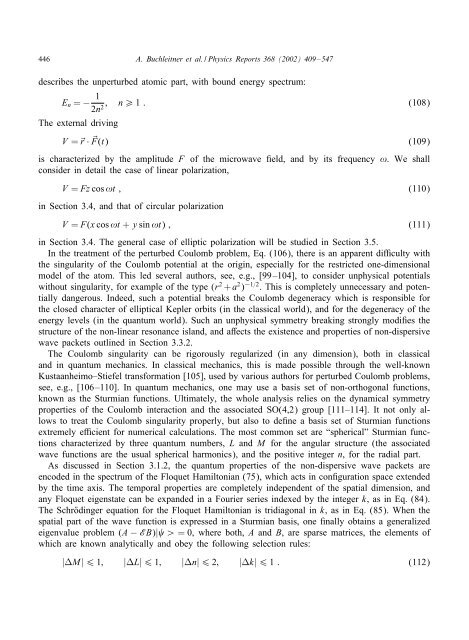Non-dispersive wave packets in periodically driven quantum systems
Non-dispersive wave packets in periodically driven quantum systems
Non-dispersive wave packets in periodically driven quantum systems
Create successful ePaper yourself
Turn your PDF publications into a flip-book with our unique Google optimized e-Paper software.
446 A. Buchleitner et al. / Physics Reports 368 (2002) 409–547<br />
describes the unperturbed atomic part, with bound energy spectrum:<br />
En = − 1<br />
;<br />
2n2 The external driv<strong>in</strong>g<br />
n¿ 1 : (108)<br />
V =˜r · ˜F(t) (109)<br />
is characterized by the amplitude F of the micro<strong>wave</strong> eld, and by its frequency !. We shall<br />
consider <strong>in</strong> detail the case of l<strong>in</strong>ear polarization,<br />
V = Fz cos !t ; (110)<br />
<strong>in</strong> Section 3.4, and that of circular polarization<br />
V = F(x cos !t + y s<strong>in</strong> !t) ; (111)<br />
<strong>in</strong> Section 3.4. The general case of elliptic polarization will be studied <strong>in</strong> Section 3.5.<br />
In the treatment of the perturbed Coulomb problem, Eq. (106), there is an apparent di culty with<br />
the s<strong>in</strong>gularity of the Coulomb potential at the orig<strong>in</strong>, especially for the restricted one-dimensional<br />
model of the atom. This led several authors, see, e.g., [99–104], to consider unphysical potentials<br />
without s<strong>in</strong>gularity, for example of the type (r 2 + a 2 ) −1=2 . This is completely unnecessary and potentially<br />
dangerous. Indeed, such a potential breaks the Coulomb degeneracy which is responsible for<br />
the closed character of elliptical Kepler orbits (<strong>in</strong> the classical world), and for the degeneracy of the<br />
energy levels (<strong>in</strong> the <strong>quantum</strong> world). Such an unphysical symmetry break<strong>in</strong>g strongly modi es the<br />
structure of the non-l<strong>in</strong>ear resonance island, and a ects the existence and properties of non-<strong>dispersive</strong><br />
<strong>wave</strong> <strong>packets</strong> outl<strong>in</strong>ed <strong>in</strong> Section 3.3.2.<br />
The Coulomb s<strong>in</strong>gularity can be rigorously regularized (<strong>in</strong> any dimension), both <strong>in</strong> classical<br />
and <strong>in</strong> <strong>quantum</strong> mechanics. In classical mechanics, this is made possible through the well-known<br />
Kustaanheimo–Stiefel transformation [105], used by various authors for perturbed Coulomb problems,<br />
see, e.g., [106–110]. In <strong>quantum</strong> mechanics, one may use a basis set of non-orthogonal functions,<br />
known as the Sturmian functions. Ultimately, the whole analysis relies on the dynamical symmetry<br />
properties of the Coulomb <strong>in</strong>teraction and the associated SO(4,2) group [111–114]. It not only allows<br />
to treat the Coulomb s<strong>in</strong>gularity properly, but also to de ne a basis set of Sturmian functions<br />
extremely e cient for numerical calculations. The most common set are “spherical” Sturmian functions<br />
characterized by three <strong>quantum</strong> numbers, L and M for the angular structure (the associated<br />
<strong>wave</strong> functions are the usual spherical harmonics), and the positive <strong>in</strong>teger n, for the radial part.<br />
As discussed <strong>in</strong> Section 3.1.2, the <strong>quantum</strong> properties of the non-<strong>dispersive</strong> <strong>wave</strong> <strong>packets</strong> are<br />
encoded <strong>in</strong> the spectrum of the Floquet Hamiltonian (75), which acts <strong>in</strong> con guration space extended<br />
by the time axis. The temporal properties are completely <strong>in</strong>dependent of the spatial dimension, and<br />
any Floquet eigenstate can be expanded <strong>in</strong> a Fourier series <strong>in</strong>dexed by the <strong>in</strong>teger k, as <strong>in</strong> Eq. (84).<br />
The Schrod<strong>in</strong>ger equation for the Floquet Hamiltonian is tridiagonal <strong>in</strong> k, as <strong>in</strong> Eq. (85). When the<br />
spatial part of the <strong>wave</strong> function is expressed <strong>in</strong> a Sturmian basis, one nally obta<strong>in</strong>s a generalized<br />
eigenvalue problem (A − EB)| ¿= 0, where both, A and B, are sparse matrices, the elements of<br />
which are known analytically and obey the follow<strong>in</strong>g selection rules:<br />
| M| 6 1; | L| 6 1; | n| 6 2; | k| 6 1 : (112)











